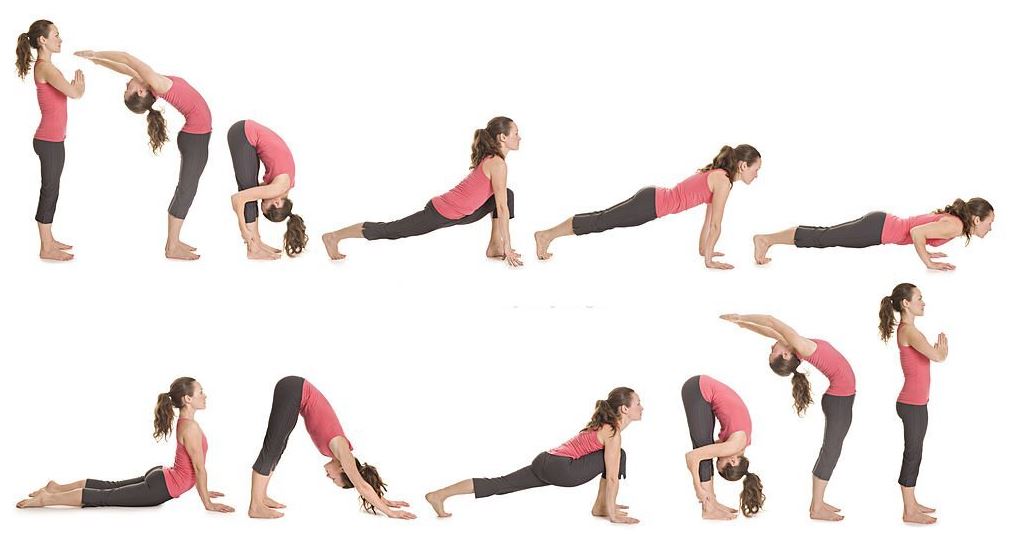Surya Namaskar, also known as Sun Salutation, is a popular yoga sequence that combines a series of twelve powerful yoga asanas (poses). It is a holistic exercise that integrates physical, mental, and spiritual well-being. In this article, we will explore the Surya Namaskar 12 Steps and delve into the numerous health benefits associated with its regular practice.
What is Surya Namaskar?
Surya Namaskar is a dynamic yoga practice that originated in ancient India. It is performed as a sequence of asanas in a flowing manner, synchronized with the breath. The word “Surya” refers to the sun, and “Namaskar” means salutation or greeting. Hence, Surya Namaskar translates to saluting the sun.
The 12 Steps of Surya Namaskar
Step 1: Pranamasana (Prayer pose)
The practice begins by standing at the front of the mat with hands joined together in prayer position at the heart center. This pose cultivates a sense of gratitude and introspection.
Step 2: Hastauttanasana (Raised Arms pose)
In this step, the practitioner extends their arms above the head, stretching the whole body. It promotes flexibility in the spine and improves lung capacity.
Step 3: Hasta Padasana (Hand to Foot pose)
The third step involves bending forward and touching the hands to the floor beside the feet. It helps in lengthening the
Step 3: Hasta Padasana (Hand to Foot pose)
The third step involves bending forward and touching the hands to the floor beside the feet. It helps in lengthening the hamstrings, calves, and spine, while also improving digestion and blood circulation.
Step 4: Ashwa Sanchalanasana (Equestrian pose)
In this step, one leg is stretched back while the other leg remains in a lunge position. It strengthens the legs, opens up the hip flexors, and improves balance and stability.
Step 5: Dandasana (Stick pose)
Dandasana is a seated pose where the body is straight and the legs are extended in front. It helps to strengthen the back muscles, improve posture, and enhance focus and concentration.
Step 6: Ashtanga Namaskara (Salute with Eight Parts)
In this step, the practitioner lowers the knees, chest, and chin to the floor, resembling a salutation with eight body parts touching the ground. It strengthens the arms, shoulders, and chest, while also improving core stability.
Step 7: Bhujangasana (Cobra pose)
Bhujangasana is a backbend where the upper body is lifted off the ground, resembling a cobra ready to strike. It increases spine flexibility, stimulates abdominal organs, and improves overall spinal health.
Step 8: Adho Mukha Svanasana (Downward Facing Dog pose)
This pose resembles an inverted “V” shape, with the hands and feet pressing into the ground. It stretches the entire body, particularly the hamstrings, calves, and shoulders. It also energizes the body and calms the mind.
Step 9: Ashwa Sanchalanasana (Equestrian pose)
Similar to Step 4, this repetition helps balance the body by stretching the other leg back. It provides a deep stretch to the hip flexors and strengthens the legs.
Step 10: Hasta Padasana (Hand to Foot pose)
Returning to Step 3, this pose is repeated to further stretch the hamstrings, calves, and spine.
Step 11: Hastauttanasana (Raised Arms pose)
In Step 2, the arms are raised again, elongating the spine and improving overall posture and lung capacity.
Step 12: Pranamasana (Prayer pose)
The final step brings the practitioner back to the starting position, standing tall with hands joined together in a prayer pose. It allows for reflection, integration of the practice, and a sense of calmness.
Health Benefits of Surya Namaskar
Surya Namaskar offers a wide range of health benefits, including physical, mental, and spiritual well-being.
Physical Benefits
- Improved Flexibility: The sequence of poses in Surya Namaskar stretches and strengthens various muscle groups, promoting overall flexibility.
- Enhanced Strength: The dynamic nature of Surya Namaskar builds strength in the arms, legs, core, and back, leading to better muscle tone and stability.
- Cardiovascular Health: The continuous flow of movements in Surya Namaskar elevates the heart rate, improving cardiovascular endurance and promoting a healthy heart.
- Weight Management: Regular practice of Surya Namaskar can aid in weight loss by increasing metabolism and burning calories.
- Improved Digestion: The forward bends and twists in Surya Namaskar stimulate the digestive organs, enhancing digestion and alleviating digestive issues.
Mental Benefits
- Stress Relief: The rhythmic movements and focused breathing in Surya Namaskar help reduce stress and anxiety, promoting a state of calm and relaxation.
- Increased Mental Clarity: The practice of Surya Namaskar improves blood circulation to the brain, increasing oxygen supply and enhancing mental clarity, focus, and concentration.
- Emotional Balance: Surya Namaskar helps balance the energy centers in the body, promoting emotional stability, positivity, and a sense of inner harmony.
- Mind-Body Connection: Through the mindful coordination of breath and movement, Surya Namaskar deepens the connection between the mind and body, fostering self-awareness and mindfulness.
Spiritual Benefits
- Energetic Alignment: Surya Namaskar activates the solar plexus, also known as the body’s energy center, enhancing vitality, intuition, and spiritual growth.
- Cultivating Inner Strength: The practice of Surya Namaskar develops inner strength, willpower, and self-discipline, nurturing a sense of inner power and resilience.
- Connection with Nature: Surya Namaskar is traditionally performed at sunrise as a salutation to the sun, symbolizing a deep connection with nature and the universe.
Incorporating Surya Namaskar into Your Routine
To incorporate Surya Namaskar into your routine, consider the following tips:
- Start Slowly: If you are new to Surya Namaskar, begin with a few rounds and gradually increase the number as your body becomes more comfortable with the practice.
- Warm-Up: Before starting Surya Namaskar, warm up your body with gentle stretches to prepare the muscles and joints.
- Practice Regularly: Consistency is key. Aim to practice Surya Namaskar at least three to four times a week to experience its full benefits.
- Modify as Needed: Feel free to modify the poses based on your fitness level and flexibility. Listen to your body and honor its limitations.
- Seek Guidance: If you are unsure about the correct alignment or sequencing of Surya Namaskar, consider seeking guidance from a qualified yoga instructor.
Conclusion
Surya Namaskar, the sequence of twelve powerful yoga poses, offers numerous physical, mental, and spiritual benefits. By incorporating Surya Namaskar into your daily routine, you can experience improved flexibility, strength, mental clarity, and a deeper connection with your inner self. So, embrace the sun salutation and embark on a transformative journey of holistic well-being.
FAQs (Frequently Asked Questions)
- Can anyone practice Surya Namaskar? Yes, Surya Namaskar can be practiced by individuals of all fitness levels. However, if you have any specific health concerns, it’s advisable to consult a healthcare professional before starting.
- How many rounds of Surya Namaskar should I do? You can start with 5 rounds and gradually increase the number as per your comfort and stamina. It’s important to listen to your body and not overexert yourself.
- When is the best time to practice Surya Namaskar? Traditionally, Surya Namaskar is practiced at sunrise. However, you can choose a time that suits your schedule and practice it on an empty stomach.
- Can Surya Namaskar help with weight loss? Regular practice of Surya Namaskar, combined with a balanced diet and a healthy lifestyle, can contribute to weight loss by boosting metabolism.
- Is it necessary to perform all 12 steps of Surya Namaskar? Ideally, it is recommended to perform all 12 steps of Surya Namaskar to experience the full benefits. Each pose has its unique advantages and contributes to the overall flow of the practice. However, modifications can be made based on individual needs and limitations.
- Can Surya Namaskar be practiced during pregnancy? Pregnant women are advised to consult their healthcare provider before practicing Surya Namaskar. Certain modifications and precautions may be necessary to ensure the safety of both the mother and the baby.
- Can Surya Namaskar be practiced by seniors? Surya Namaskar can be beneficial for seniors as it promotes flexibility, strength, and mental well-being. However, it’s important for seniors to practice under the guidance of a qualified instructor who can provide appropriate modifications and ensure safety.
- What if I have limited flexibility or joint issues? If you have limited flexibility or joint issues, you can modify the poses in Surya Namaskar to suit your needs. Use props such as blocks or straps to assist you in achieving proper alignment and gradually work on improving your flexibility with regular practice.
- Can Surya Namaskar be practiced by children? Yes, children can practice Surya Namaskar under the guidance of a qualified instructor or in a suitable yoga class designed for their age group. It can help children develop body awareness, strength, and focus.
- Can Surya Namaskar be practiced on a mat or any flat surface? Surya Namaskar can be practiced on a yoga mat or any flat and comfortable surface that provides adequate support. Ensure that the surface is clean and free from obstacles to prevent any injuries.
Remember to always listen to your body, practice with awareness, and enjoy the journey of Surya Namaskar. Embrace the benefits it offers for your physical, mental, and spiritual well-being.



